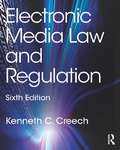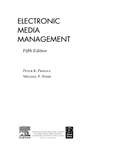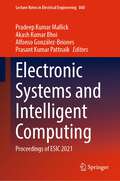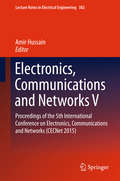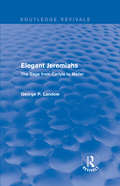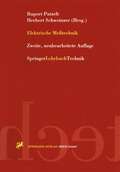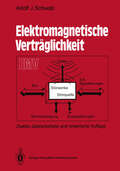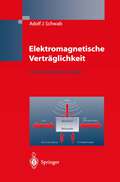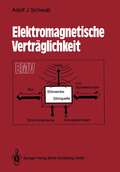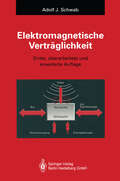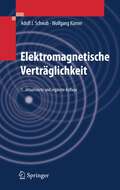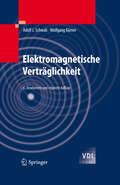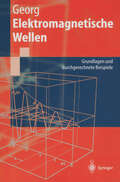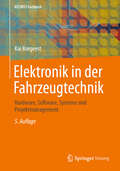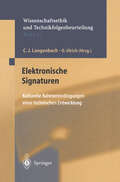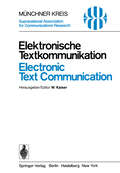- Table View
- List View
Electronic Media Law and Regulation
by Kenneth C. CreechElectronic Media Law and Regulation is a case-based law text that provides students with direct access to case law as well as the context in which to understand its meaning and impact. The text overviews the major legal and regulatory issues facing broadcasting, cable, and developing media in today's industry. Presenting information from major cases, rules, regulations, and legal documents in a concise and readable form, this book helps current and prospective media professsionals understand the complex realm of law and regulation. Students will learn how to avoid common legal pitfalls and anticipate situations that may have potential legal consequences. This sixth edition provides annotated cases with margin notes, and new chapters address such timely issues as media ownership, freedom of information, entertainment rights, and cyber law.
Electronic Media Management, Revised
by Peter Pringle Michael F StarrThe fifth edition of a classic text features important updates that reflect the enormous changes that have taken place in recent years - the Internet as an important information transmission format that is here to stay and convergence among media. This edition features thorough discussions on the Internet and convergence, as well as reflects the latest information on broadcast and cable regulations and policies. It also includes a fresh batch of case studies, and study questions. As in previous editions, this book also covers management theory, audience analysis, broadcast promotion, and marketing.
Electronic Media Management, Revised
by Peter Pringle Michael F StarrThe fifth edition of a classic text features important updates that reflect the enormous changes that have taken place in recent years - the Internet as an important information transmission format that is here to stay and convergence among media. This edition features thorough discussions on the Internet and convergence, as well as reflects the latest information on broadcast and cable regulations and policies. It also includes a fresh batch of case studies, and study questions. As in previous editions, this book also covers management theory, audience analysis, broadcast promotion, and marketing.
Electronic Quills: A Situated Evaluation of Using Computers for Writing in Classrooms (Technology and Education Series)
by Bertram C. Bruce Andee Rubin with contributi Barnhardt and TeachersThis volume centers on the words and experiences of teachers and students who used QUILL -- a software package developed by the authors to aid in writing instruction. It looks in detail at the stories of these early users and considers questions relevant for other teachers, students, researchers, and developers of educational innovations. Questions posed include: * What does it mean to develop an environment for literacy in an actual classroom? * How can a teacher create an environment in which students work together toward meaningful goals? * How can a teacher promote the rich communication so necessary for developing language? * What is the role of technology in the practice and development of literacy? The examination of the QUILL experiences provides a fuller and more revealing account of what it meant to use QUILL than would have been possible through standard evaluation techniques. At the same time, the focus on the particulars also finds analogues in analyses of similar pieces of open-ended software or educational innovations in general.
Electronic Quills: A Situated Evaluation of Using Computers for Writing in Classrooms (Technology and Education Series)
by Bertram C. Bruce Andee Rubin with contributi Barnhardt and TeachersThis volume centers on the words and experiences of teachers and students who used QUILL -- a software package developed by the authors to aid in writing instruction. It looks in detail at the stories of these early users and considers questions relevant for other teachers, students, researchers, and developers of educational innovations. Questions posed include: * What does it mean to develop an environment for literacy in an actual classroom? * How can a teacher create an environment in which students work together toward meaningful goals? * How can a teacher promote the rich communication so necessary for developing language? * What is the role of technology in the practice and development of literacy? The examination of the QUILL experiences provides a fuller and more revealing account of what it meant to use QUILL than would have been possible through standard evaluation techniques. At the same time, the focus on the particulars also finds analogues in analyses of similar pieces of open-ended software or educational innovations in general.
Electronic Systems and Intelligent Computing: Proceedings of ESIC 2021 (Lecture Notes in Electrical Engineering #860)
by Pradeep Kumar Mallick Akash Kumar Bhoi Alfonso González-Briones Prasant Kumar PattnaikThis book is a compilation of contributed research work from International Conference on Electronic Systems and Intelligent Computing (ESIC 2021) and covers the areas of electronics, communication, electrical and computing. This book is specifically targeted to the students, research scholars and academician from the background of electronics, communication, electrical and computer science. Advances in electronics, communication, electrical and computing cover the different approaches and techniques for specific applications using particle swarm optimization, Otsu’s function and harmony search optimization algorithm, DNA-NAND gate, triple gate SOI MOSFET, micro-Raman and FTIR analysis, high-k dielectric gate oxide, spectrum sensing in cognitive radio, microstrip antenna, GPR with conducting surfaces, energy-efficient packet routing, iBGP route reflectors, circularly polarized antenna, double fork-shaped patch radiator, implementation of Doppler radar at 24 GHz, iris image classification using SVM, digital image forgery detection, secure communication, spoken dialog system and DFT-DCT spreading strategies.
Electronic Technology and Civil Procedure: New Paths to Justice from Around the World (Ius Gentium: Comparative Perspectives on Law and Justice #15)
by Miklós Kengyel and Zoltán NemessányiThe effect of modern and communication technology on civil procedure first appeared on the agenda of the conference organized by the International Association of Procedural Law in 1999, verifying Lord Woolf’s statement from the 90’s, that ”IT will not only assist in streamlining and improving our existing systems and process; it is also likely, in due course, itself to be catalyst for radical change as well...”. At the conference in Pecs in the autumn of 2010 participants from three continents and twenty-five countries examined all aspects of the impact of modern information technology on civil procedure beginning with the electronic submission of the application, ranging from electronic service of documents and electronic means of proof supported by modern information technology. In addition to the practical issues they discussed the possible impact of electronic procedures on traditional principles of civil procedure. The conference book contains seven main reports and eleven correferates, the foreword was written by Prof. Peter Gottwald, the President of the International Association of Procedural Law.
Electronics, Communications and Networks V: Proceedings of the 5th International Conference on Electronics, Communications and Networks (CECNet 2015) (Lecture Notes in Electrical Engineering #382)
by Amir HussainThis book comprises peer-reviewed contributions presented at the 5th International Conference on Electronics, Communications and Networks (CECNet 2015), held in Shanghai, China, 12-15 December, 2015. It includes new multi-disciplinary topics spanning a unique depth and breadth of cutting-edge research areas in Electronic Engineering, Communications and Networks, and Computer Technology. More generally, it is of interest to academics, students and professionals involved in Consumer Electronics Technology, Communication Engineering and Technology, Wireless Communication Systems and Technology, and Computer Engineering and Technology.
Electronics for Service Engineers
by Dave FoxElectronics for Service Engineers is the first text designed specifically for the Level 2 NVQs in Electronics Servicing. It provides the underpinning knowledge required by brown goods and white goods students, reflecting the popularity of the EMTA white goods NVQs. It has also been written in the light of the new EEB / City & Guilds Level 2 progression award (RVQ) for brown goods and commercial electronics, dubbed 'son of 2240', and the existing 2240 part 1. The wide ranging experience of the authors makes this a readable book with much relevance to the real-life challenges of the service engineer. From simple mathematics and circuit theory to transmission theory and aerials, from health and safety to logic gates and transducers, the complete range of knowledge required to service electronic and electrical equipment is here. This practical emphasis makes the book ideal for existing service engineers seeking to gain an NVQ. Numerous questions and worked examples throughout the text allow readers to monitor their own progress, and provide practice for C&G tests.Joe Cieszynski and Dave Fox have a wide mix of experience, both in the field and workshop working on TV and audio, and teaching electronic servicing and security installation at MANCAT. Joe writes regularly for Television magazine.
Electronics for Service Engineers
by Dave FoxElectronics for Service Engineers is the first text designed specifically for the Level 2 NVQs in Electronics Servicing. It provides the underpinning knowledge required by brown goods and white goods students, reflecting the popularity of the EMTA white goods NVQs. It has also been written in the light of the new EEB / City & Guilds Level 2 progression award (RVQ) for brown goods and commercial electronics, dubbed 'son of 2240', and the existing 2240 part 1. The wide ranging experience of the authors makes this a readable book with much relevance to the real-life challenges of the service engineer. From simple mathematics and circuit theory to transmission theory and aerials, from health and safety to logic gates and transducers, the complete range of knowledge required to service electronic and electrical equipment is here. This practical emphasis makes the book ideal for existing service engineers seeking to gain an NVQ. Numerous questions and worked examples throughout the text allow readers to monitor their own progress, and provide practice for C&G tests.Joe Cieszynski and Dave Fox have a wide mix of experience, both in the field and workshop working on TV and audio, and teaching electronic servicing and security installation at MANCAT. Joe writes regularly for Television magazine.
Electrooptical Arrays
by Dmitrii I. Voskresenskii Aleksandr I. Grinev Evgenii N. VoroninModern radar, telecommunication, sonar, and radio-astronomy systems use integrated systems, complex signals, and signal processing methods exten sively. These systems require the development of new, more efficient systems. One of the major ways to improve radar and sonar systems is to use multichannel systems, the most promising of which employ space-time signal processing. In the last few years the intensive growth in electronics, informa tion processing techniques, microwave and laser technology, electrooptics and holography, acoustics, and optoelectronics have resulted in new scientific and technological research fronts. One of these is the theory and technology of electrooptical array antennas-a new class of receiving antennas whose pat tern is controlled by means of coherent optics and holography. Electrooptical array theory and technology have been involved in the study of the power, resolution, and range characteristics of arrays with various coherent opti cal processors. The practical applications of these systems and methods for building them using contemporary optoelectronics have also been studied.
Elegant Jeremiahs: The Sage from Carlyle to Mailer (Routledge Revivals)
by George P. LandowLabelled "an elegant Jeremiah" by a journalist of his day, the urbane Victorian Matthew Arnold must have received the comparison with the Old Testament prophet uneasily. Writing in the 1970s, Norman Mailer seems to owe nothing to the biblical for his description of a long hot wait to buy a cold drink while reporting on the first voyage to the moon. Yet both Arnold and Mailer, George P. Landow asserts in this book, are sages, writers in the nonfiction prose form of secular prophecy, a genre richly influenced by the episodic structures and harshly critical attitudes toward society which characterize Old Testament prophetic literature. In this book, first published in 1986, Landow defines the genre by exploring its rhetoric, an approach that enables him to illuminate the relationships among representative works of the nineteenth century to one another, to biblical, oratorical, and homiletic traditions, and to such twentieth-century writers as Lawrence, Didion, and Mailer.
Elegant Jeremiahs: The Sage from Carlyle to Mailer (Routledge Revivals)
by George P. LandowLabelled "an elegant Jeremiah" by a journalist of his day, the urbane Victorian Matthew Arnold must have received the comparison with the Old Testament prophet uneasily. Writing in the 1970s, Norman Mailer seems to owe nothing to the biblical for his description of a long hot wait to buy a cold drink while reporting on the first voyage to the moon. Yet both Arnold and Mailer, George P. Landow asserts in this book, are sages, writers in the nonfiction prose form of secular prophecy, a genre richly influenced by the episodic structures and harshly critical attitudes toward society which characterize Old Testament prophetic literature. In this book, first published in 1986, Landow defines the genre by exploring its rhetoric, an approach that enables him to illuminate the relationships among representative works of the nineteenth century to one another, to biblical, oratorical, and homiletic traditions, and to such twentieth-century writers as Lawrence, Didion, and Mailer.
Elektrische Meßtechnik
by Rupert Patzelt Herbert SchweinzerDieses Werk hat sich in kurzer Zeit als Standardlehrbuch der Meßtechnik etabliert. Für die zweite, neubearbeitete Auflage wurden nicht nur Fehler korrigiert, sondern der ganze Stoff gründlich überarbeitet und erweitert. Neu hinzugekommen sind Kapitel über Abtastung und Rekonstruktion von Zeitverläufen, und über Sensorprinzipien. Ein eigenes Kapitel über Meßdatenerfassung und -darstellung trägt der rasanten Entwicklung auf diesem Sektor Rechnung. Besonders wichtig ist immer die Überlegung, welche Einflüsse bei Meßvorgängen vernachlässigt werden können, bzw. welchen Einfluß diese Effekte haben können. Die dargestellten Meßmethoden und Schaltungen folgen bewährten Prinzipien, technische Details von Meßgeräten wurden soweit reduziert, daß die Aktualität der Darstellung gewahrt bleibt.
Elektromagnetische Felder und Netzwerke: Anwendungen in Mathcad und PSpice (Springer-Lehrbuch)
by Otfried GeorgElektromagnetische Verträglichkeit
by Adolf J. SchwabDas Buch behandelt die Vielzahl parasitärer elektromagnetischer Phänomene, die sich beispielsweise bei wachsendem Einsatz der Mikroelektronik in der Steuerungs- und Automatisierungstechnik zunehmend als problematisch herausstellen bezüglich Zuverlässigkeit und Sicherheit der Funktion elektrotechnischer Geräte und Anlagen. Der moderne Oberbegriff "Elektromagnetische Verträglichkeit" faßt die in den verschiedenen Anwendungsgebieten unterschiedlich bezeichneten Phänomene zusammen, die in diesem Buch allgemeingültig und verständlich behandelt werden. Ausgehend von den physikalischen Grundlagen werden die Zusammenhänge aufgezeigt und Wege gewiesen, um nicht gewünschte Nebenwirkungen zuverlässig zu vermeiden.
Elektromagnetische Verträglichkeit
by Adolf J. SchwabElektromagnetische Verträglichkeit (EMV) ist ein moderner Oberbegriff für die Beherrschung parasitärer elektromagnetischer Phänomene. Sie sind bisher in den verschiedenen Anwendungsbereichen als Funkstörungen, Netzrückwirkungen, Überspannungen, Netzflicker, 50Hz-Brummen, Erdschleifen usw. bezeichnet worden. Sie lassen sich allgemeingültig behandeln, wenn man auf die physikalischen Grundlagen zurückgeht und die Zusammenhänge aufzeigt. Der Inhalt dieser Neuauflage wurde erneut didaktisch verbessert und der Normenteil um die zahlreichen inzwischen erschienenen Europanormen und Nationalen Normen erweitert.
Elektromagnetische Verträglichkeit
by Adolf J. SchwabElektromagnetische Verträglichkeit (EMV) ist ein moderner Oberbegriff für die Beherrschung parasitärer elektromagnetischer Phänomene, die schon immer existent sind, sich aber zunehmend als problematisch herausstellen. Sie sind bisher in den verschiedenen Anwendungsbereichen als Funkstörung, Netzrückwirkungen, Überspannungen, Netzflicker, 50Hz-Brummen, Erdschleifen usw. bezeichnet worden. EMV-Fragen haben durch den Einsatz der Mikroelektronik in Automatisierungssystemen, Stromrichtern und Kraftfahrzeugen und durch die allgemein gestiegene elektromagnetische Umweltbelastung besondere Bedeutung erlangt. EMV-Phänomene lassen sich allgemeingültig behandeln, wenn man auf die physikalischen Grundlagen zurückgeht und die Zusammenhänge aufzeigt. Dieses Buch dient daher nicht nur als verständliche Einführung für Studenten, sondern als Übersichtswerk für Entwickler, Hersteller und Ingenieure aller Disziplinen.
Elektromagnetische Verträglichkeit
by Adolf J. Schwab Wolfgang KürnerElektromagnetische Verträglichkeit (EMV) ist ein moderner Oberbegriff für die Beherrschung parasitärer elektromagnetischer Phänomene. Die 5., aktualisierte und ergänzte Neuauflage wurde erneut didaktisch verbessert. Die Autoren erweiterten sie um die zahlreichen inzwischen erschienenen Europanormen und nationalen Normen. Besonders wertvoll für Hersteller: die aktualisierte Darstellung zur Erlangung der ab sofort erforderlichen CE-Kennzeichnung.
Elektromagnetische Verträglichkeit (VDI-Buch)
by Adolf J. Schwab Wolfgang KürnerDie enge Nachbarschaft von Elektronikkomponenten und der Einsatz drahtloser Übertragungstechniken können Störungen verursachen. Elektromagnetische Verträglichkeit (EMV) ist daher für die Elektronikentwicklung unentbehrlich. In dem Band beschreiben die Autoren den Weg zum EMV-konformen Produkt und befähigen Hersteller damit, ihre Systeme selbst zu analysieren. Die Neuauflage berücksichtigt die Neufassung des EMV-Gesetzes (2008), sie wurde um neue Verfahren der Leistungsbestimmung in komplexen Systemen ergänzt, das Thema innerer Blitzschutz erweitert.
Elektromagnetische Wellen: Grundlagen und durchgerechnete Beispiele (Springer-Lehrbuch)
by Otfried GeorgFür Studenten der Elektrotechnik und Technischen Informatik in der praxisorientierten Ausbildung. Besonderer Wert wurde deshalb auf die einführende und anschauliche, jedoch knappe Darstellung und auf Lernhilfen gelegt. Zielsetzung ist die Vermittlung von möglichst viel physikalischem und daraus resultierendem technischen Wissen unter Verwendung von möglichst wenig Mathematik.
Elektronik in der Fahrzeugtechnik: Hardware, Software, Systeme und Projektmanagement (ATZ/MTZ-Fachbuch)
by Kai BorgeestDas Buch vermittelt die Grundlagen, um die Besonderheiten der Elektronik und Software im Kfz nicht nur zu kennen, sondern auch zu verstehen. Zusätzlich wird an Beispielen die Komplexität realer Systeme im Fahrzeug vorgeführt und gezeigt, welche Anwendungen durch die Elektronik erst möglich werden. Das Spannungsfeld zwischen Sicherheit, Zuverlässigkeit und Komplexität prägt in Verbindung mit branchenüblichen Abläufen das Vorgehen bei der Entwicklung, das ein in diesem Bereich tätiger Ingenieur verstehen muss.
Elektronische Signaturen: Kulturelle Rahmenbedingungen einer technischen Entwicklung (Ethics of Science and Technology Assessment #12)
by G. Kamp F. WütscherErst die elektronische Signatur wird dem E-Commerce zum Durchbruch verhelfen. Dieses Werk setzt sich mit den Akzeptanzproblemen auseinander, die beim Einsatz moderner Technologien für die vertrauenswürdige elektronische Kommunikation entstehen. Rechtliche Fragen spielen hier eine wichtige Rolle, aber auch Moral und Kultur. Die Situation in diesen Bereichen wird im Buch diskutiert und daraus Handlungsempfehlungen für den Verbraucher- und Datenschutz, die technische Ausgestaltung sowie den Umgang mit Risiken gegeben. Dies führt zu einem visionären Modell der Informationsgesellschaft.
